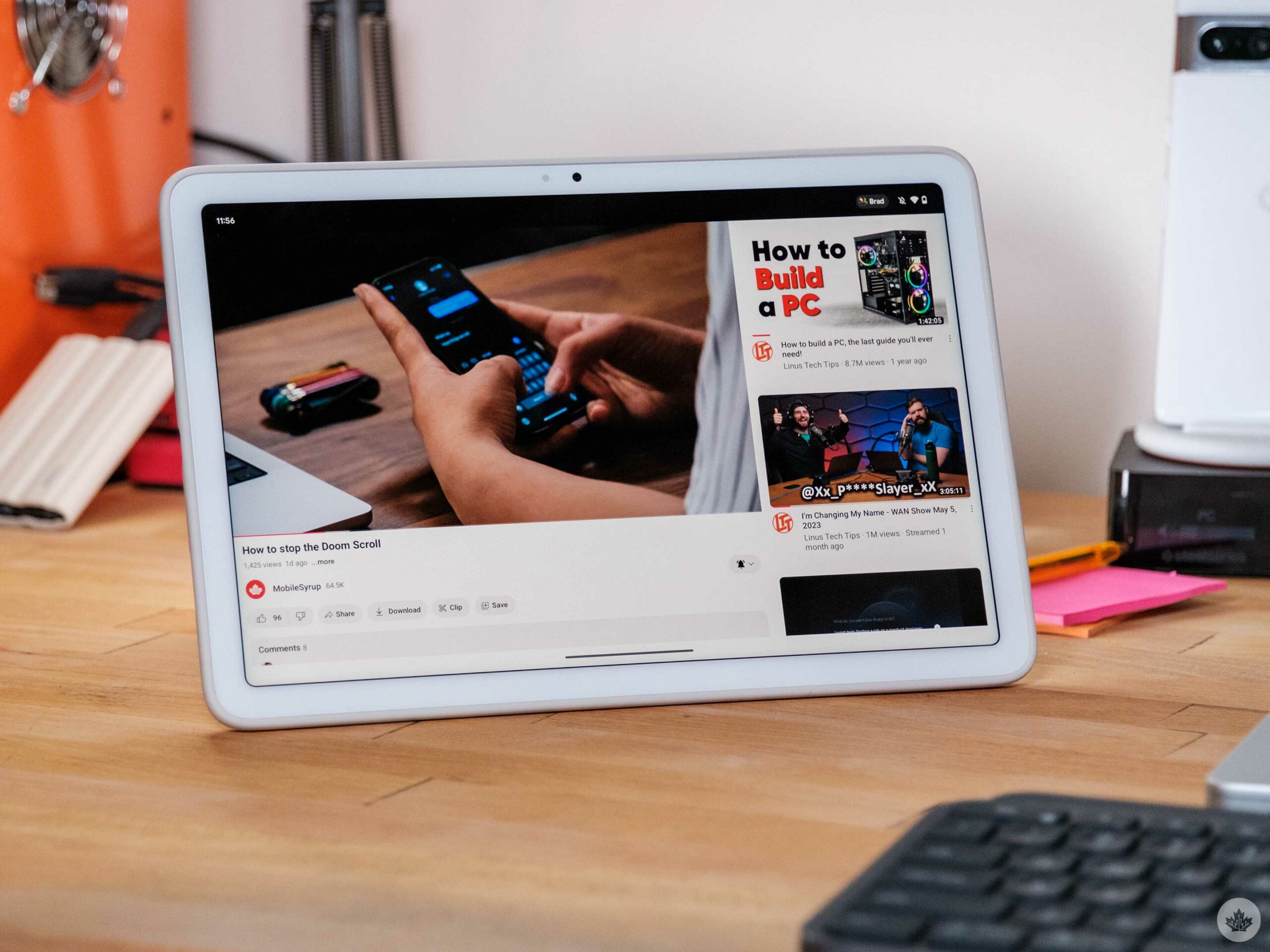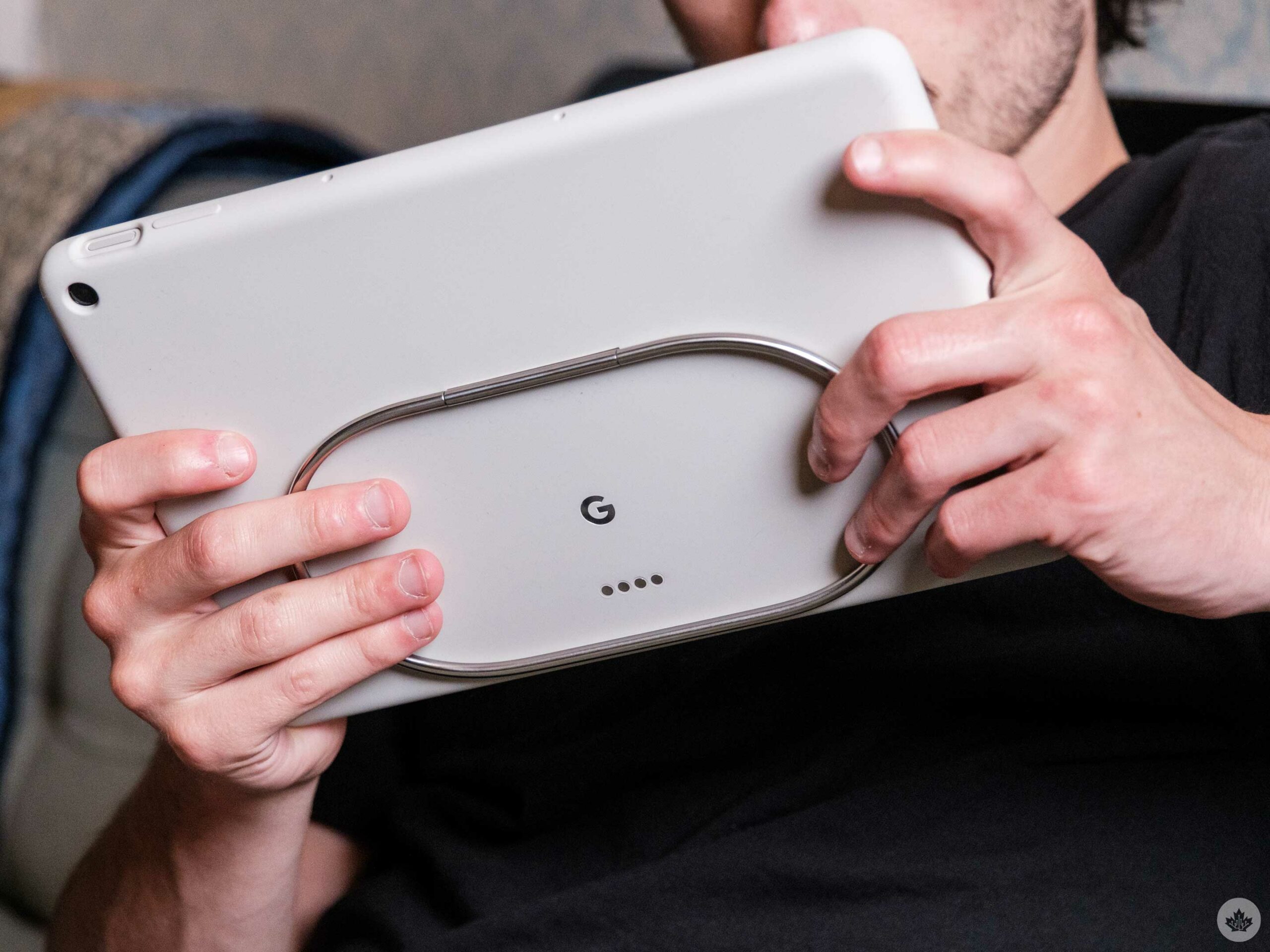The Pixel Tablet is Google’s best chance at making a dent in the tablet market since 2013’s Nexus 7. This time the goal isn’t a portable tablet but rather a companion screen to use around your home.
For many, this may fall flat, but for those of us that use laptops and phones too much for productivity tablets to be worth buying, this device hits the sweet spot. It’s not overpowered or bogged down with features — it just runs video well, and when I dock it, I can ask it to play music from across the room or set a timer.
There are a few software bugs, but the overall experience feels forward-thinking and well-thought-out. It has some of that “it just works magic,” and the overall concept is solid. If Google can overcome the software hurdles with updates, it will have an amazing multi-use device.
Built for YouTube
I’m not going to shy away from it. I watch a lot of video content, and the Pixel Tablet is perfect this. While it doesn’t feature an outstanding OLED panel with 120Hz like the OnePlus Pad, it has accurate colour representation, and unless you’re in direct sunlight, it’s viewable from a pretty wide angle with no visible pixels.
It has four speakers providing a loud soundscape that gets even louder when you dock it. However, I really only listen to music on the dock due to the nature of where it’s placed in my office. You can cover the tablet speakers a bit when it’s in two hands, but for the most part, it’s more than loud enough since the other speakers pick up the slack.
That said, I spent a lot of time with the tablet propped up in front of me on a table or nightstand with the Google-designed Pixel Tablet Case. At this point, I don’t think I could imagine using a tablet without a kickstand case.![]() Google’s is excellent, and the ring that goes around the dock is a smart mix of style and product design, but as Jon said in his experience post, it feels like a rip-off at $108. Sadly, there aren’t any other good options on the market that also work with the dock and look nice, so it’s a pretty necessary add-on to get the whole experience.
Google’s is excellent, and the ring that goes around the dock is a smart mix of style and product design, but as Jon said in his experience post, it feels like a rip-off at $108. Sadly, there aren’t any other good options on the market that also work with the dock and look nice, so it’s a pretty necessary add-on to get the whole experience.
Where the Pixel Tablet does fall out of my favour is with social media. None of the popular apps run well on the tablet since they’re all just blown-up phone apps. They’re usable, but it feels janky for a $700 tablet ($808 with the case). It gets a bit better if you run two of these apps side-by-side or with the tablet in portrait orientation, but it’s a sloppy fix. Especially since the rest of the tablet feels designed to be held in landscape.
 The speaker dock hardware is also a weird price conundrum. For some reason, it’s $180 in Canada and could benefit from being a bit heavier to make it feel more solid when you lift the tablet off. As an outcome of the lightweight dock, the magnets are weak to make up for it, but this means every time you manually attempt to adjust the volume, the force of pushing the buttons knocks the tablet off the base. After a while, you get used to it and adjust how you use the volume, but a heavier base and stronger magnets would go a long way toward making this tablet/dock combo feel more deserving of its premium price tag.
The speaker dock hardware is also a weird price conundrum. For some reason, it’s $180 in Canada and could benefit from being a bit heavier to make it feel more solid when you lift the tablet off. As an outcome of the lightweight dock, the magnets are weak to make up for it, but this means every time you manually attempt to adjust the volume, the force of pushing the buttons knocks the tablet off the base. After a while, you get used to it and adjust how you use the volume, but a heavier base and stronger magnets would go a long way toward making this tablet/dock combo feel more deserving of its premium price tag.
The perfect Pixel portfolio?
![]() Hot on the heels of the Pixel Watch, the tablet comes in just as Google claims to be committing to an entire Pixel hardware portfolio. The company has done a good job echoing the playbook perfected by Apple a few years ago, but there’s no denying that Google’s track record for killing products hangs heavy over this whole endeavour.
Hot on the heels of the Pixel Watch, the tablet comes in just as Google claims to be committing to an entire Pixel hardware portfolio. The company has done a good job echoing the playbook perfected by Apple a few years ago, but there’s no denying that Google’s track record for killing products hangs heavy over this whole endeavour.
The Pixel Tablet, like Google’s Watch, is a first-generation product, and while the infancy of those products makes them exciting, it also leaves them vulnerable to software that doesn’t feel fully ironed out. Similar to the OnePlus Pad, widgets are wonky and get even wonkier when you turn your tablet 90 degrees. You also have tons of widget space on the home screen, but you’re forced to keep the ‘At-a-glance’ feature pinned in the top left, negating the need for any cool weather widgets since having the weather twice on my home screen is redundant.
 None of these kill the Pixel Tablet experience since it’s more about watching videos or browsing the web, but it speaks to the shortcomings of Android on tablets. We can hope that the Pixel and OnePlus tablets hitting the markets alongside the growing popularity of large-screen foldable phones will help Android push through this, but it will be a risk for the first few years at least. And we all know how much of a stomach Google has for a multi-year gamble.
None of these kill the Pixel Tablet experience since it’s more about watching videos or browsing the web, but it speaks to the shortcomings of Android on tablets. We can hope that the Pixel and OnePlus tablets hitting the markets alongside the growing popularity of large-screen foldable phones will help Android push through this, but it will be a risk for the first few years at least. And we all know how much of a stomach Google has for a multi-year gamble.
There are a few Google ecosystem perks, like the ability to link your Android Messages app so you can text from the Tablet. Again, for lack of a better comparison, it’s not as easy to set up as iMessage since it’s basically the same app as Android Messages on the web. Still, it works once set up and makes the device fill in for your phone when you’re carrying it around — a nice touch since no one wants to carry a phone and tablet around at home.
![]() Regardless of the outcome of the first Pixel Tablet, I hope Google has a multi-year plan for tablets. If the company wants to remain a flagship brand, it needs to act like one in the consumer space, and the only way to get noticed is to innovate year after year. The Pixel Tablet is a brilliant idea, and it would be a shame to see another company refine the idea with Google this close to perfection.
Regardless of the outcome of the first Pixel Tablet, I hope Google has a multi-year plan for tablets. If the company wants to remain a flagship brand, it needs to act like one in the consumer space, and the only way to get noticed is to innovate year after year. The Pixel Tablet is a brilliant idea, and it would be a shame to see another company refine the idea with Google this close to perfection.
A screen for the future held back by the past
 Somehow against all the odds, the Pixel Tablet has integrated perfectly into my life. Who knew how much power a big charged-up screen would have over me? I find myself reaching for it all the time, and if you’re like me and enjoy YouTube as background when you’re doing chores around the house or streaming TV when you’re sitting outside, the nature of the Pixel Tablet having a dock is perfect. It’s always charged and has a home where I know it always is, waiting to be picked up.
Somehow against all the odds, the Pixel Tablet has integrated perfectly into my life. Who knew how much power a big charged-up screen would have over me? I find myself reaching for it all the time, and if you’re like me and enjoy YouTube as background when you’re doing chores around the house or streaming TV when you’re sitting outside, the nature of the Pixel Tablet having a dock is perfect. It’s always charged and has a home where I know it always is, waiting to be picked up.
It would be nice if Google could maximize its tablet/smart home combo software, but I guess I’m just happy with a big screen that feels very comfortable floating around my home playing media. I rarely feel like I get the maximum use out of my smart displays or tablets, but this device changed that, and now those auxiliary devices I barely use turned into one that seems good enough to be the jack-of-all-trades computer in my home.
I’m a massive fan of the Pixel Tablet, I would buy more docks in a heartbeat if they were more functional or affordable. If you like watching content and don’t already have a tablet or a smart display, this is the perfect device for you.
For more on Google’s Pixel tablet, check out Dean Daley and Jon Lamont’s thoughts on the device.
MobileSyrup may earn a commission from purchases made via our links, which helps fund the journalism we provide free on our website. These links do not influence our editorial content. Support us here.


